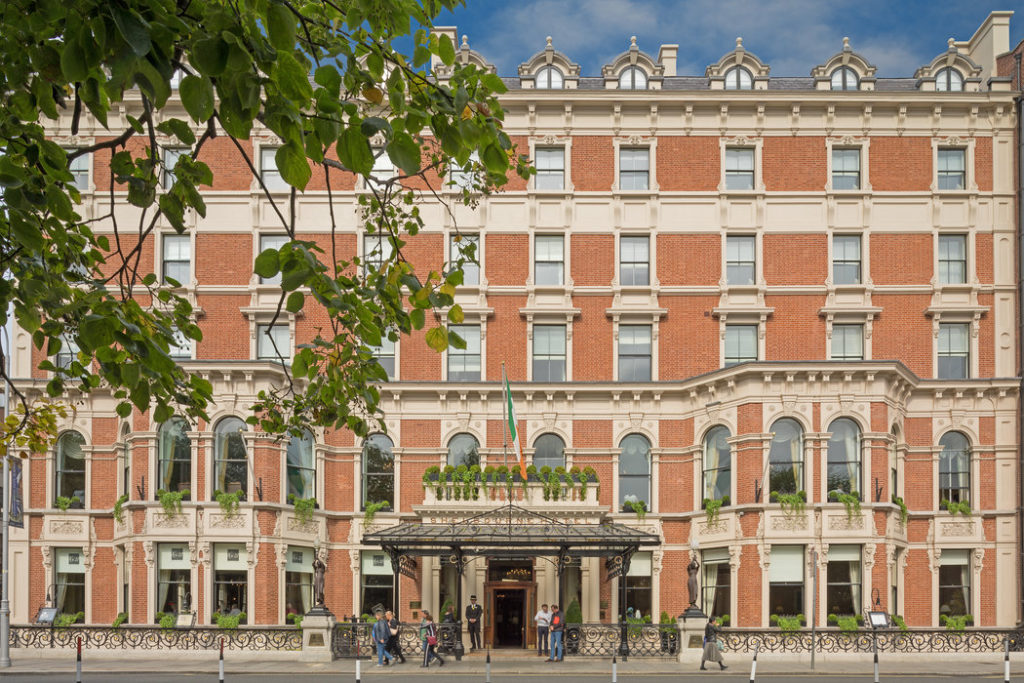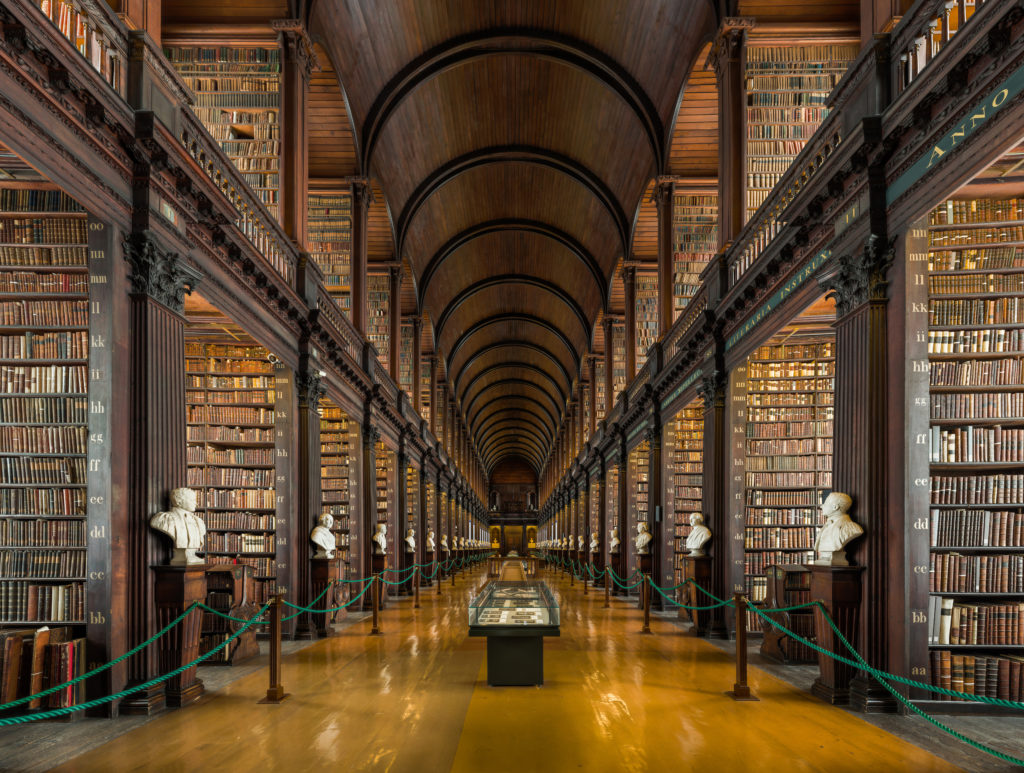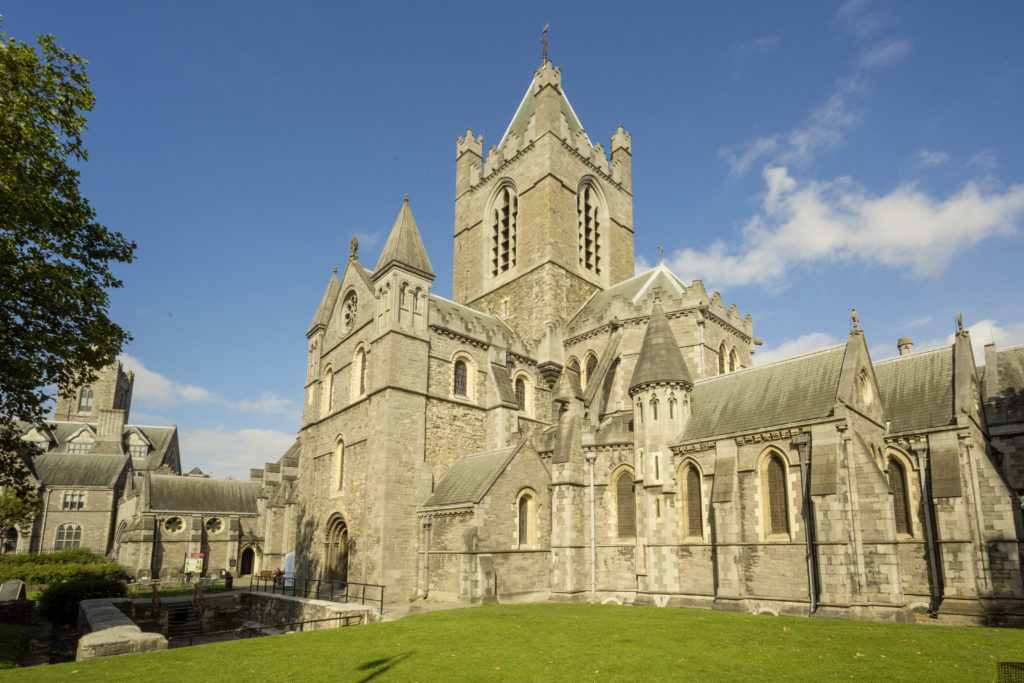IT REMAINS one of the great cities of Europe.
The invader, the trader, the traveller, the settler, the oppressor, the rebel and the writer have all added colour and culture to Dublin, to Baile Átha Cliath, to Dubh Linn.
Few places have produced so many heavy hitters in the literary field— Swift, Joyce, Shaw, Wilde, Beckett, Behan. Plus the greatest horror-writer of them all, Bram Stoker.
Lesser-known writers too: Dublin man Robert Tressell, born Robert Noonan in 1870, left for England where he wrote The Ragged Trousered Philanthropists, exposing the harsh realities of working-class life.
Their ghosts lurk in every corner of Dublin.
The city that produced these writers along with the political thinker Edmund Burke, social reformer Dr Barnardo, the artist Francis Bacon, the Duke of Wellington and U2, hasn’t changed that much in character over the years, despite the many superficial changes.
Dublin is in equal measure thoughtful and frivolous, decadent and pious, creative and convivial — and undoubtedly one of the great cities of the world.
Between the reels and jigs
THE COBBLESTONE in Smithfield is basically pints on the table and music in the air. Sessions, gigs, classes, talks, dances — you can expect them all. For a more choreographed story of one arm of Irish music, traditional dance, head for nearby Jig, the Story of Irish Dance located at the theatre within the Powerscourt Centre. Jig is a show featuring performers who take audiences, yes, step by step, through the history of Irish dance, explaining it all.
A 'Hop Up', an interactive option for those who want to learn to dance themselves. Take to the floor. Speaking as someone who really only dances when no one is looking, I was a tad more interested in the Irish Dance Museum in the same part of Powerscourt and which is covered by your admission ticket.
jigtheirishdance.com
Park and recreation, plus history
STEPHEN'S GREEN, an exquisitely manicured park, dates back to a time when open space and fresh air were at a premium: Victorian Ireland, 1880.
In 1880 Sir Arthur Edward Guinness, later Lord Ardilaun, funded its restoration and opened it to the public.
Today, it remains a green refuge in the city, popular with office workers, tourists and students alike.
The park bears the imprint of Irish political and cultural history. The Fusiliers’ Arch at the Grafton Street entrance commemorates Royal Dublin Fusiliers killed in the Second Boer War and bears marks consistent with 1916 gunfire. During the Easter Rising, members of the Irish Citizen Army under Michael Mallin and Countess Markievicz briefly occupied the park before retreating to the nearby Royal College of Surgeons.
On the south side, a bronze bust of James Joyce, sculpted by Marjorie Fitzgibbon in 1982, faces Newman House, which housed University College Dublin during Joyce’s student years.
More drinks, please
DOHENY & NESBITT’S pub near St Stephen’s Green was crowded. It was still early on a Tuesday lunchtime, but already all the mahogany-lined and glass-fronted snugs were taken.
The buzz from the clientele was already rising — office workers, groups of businessmen, visitors, locals, were enjoying the Guinness or tucking into hearty food.
The barman approached through the throng, multi-tasking on the way: cleaning tables, stacking empty glasses, dispensing racing tips to a snugful of construction workers, keeping his eye on the Guinness taps.
He arrived at our table with the lunchtime menu. “Ach,” he said, “there has to be an easier way to make a thousand euro a week.”
dohenyandnesbitts.ie
Stories in every snug, every sip
THE Palace on Dublin’s Fleet Street is one of the great bars of the world, in the same company as the Bull and Castle on Lord Edward Street, near Christ Church. Both are almost the embodiment of “Dublin in the rare ould times”.
At the Shelbourne Hotel, waiting staff in black and white livery will sway as they carry silver platters of gleaming black Carlingford and Galway oysters through the famous Horseshoe Bar.
As well as being a five-star slice of studied luxury overlooking St Stephen’s Green, the Shelbourne resounds with echoes from Ireland’s momentous past. This is where, you will be told by the barman, two very significant events in Irish history happened: the drawing up of the Irish Constitution and the creating of Black Velvet, the Guinness and champagne cocktail.
Unlike most other pubs in Dublin which have been frequented by a battalion of the finest writers in the English language, Ryan's in Parkgate is notable in that Ludwig von Wittgenstein was a local.
The philosopher regularly sat in the pub, doubtless thinking thoughts along the lines of: “Whereof one cannot speak, thereof there must be silence.”
Philosophy, eh? Makes you think.
While reflecting on religion — which would have been relatively easy in Dublin, he said: “If there were a verb meaning ‘to believe falsely’, it would not have any significant first person, present indicative.”
 The Shelbourne Hotel, Dublin (Pic: Tourism Ireland)
The Shelbourne Hotel, Dublin (Pic: Tourism Ireland)A Dublin rite of passage
NO VISIT to Dublin’s coast is complete without a stop at the Forty Foot, the legendary bathing spot at Sandycove, just a short DART ride from the city centre. Once an exclusive gentlemen’s swimming club in the 19th century, the Forty Foot is now open to all, year-round, regardless of weather or water temperature. A cool tradition.
Despite its name, it isn’t exactly 40 feet deep — but no one can quite agree where the title comes from. Some say it refers to a British regiment once stationed nearby; others suggest it was just a convenient nautical exaggeration.
No one can, ahem, fathom it. What is certain is that the spot has been drawing brave bathers for over 150 years.
The Forty Foot crops up in Irish literary history. James Joyce set the opening scene of Ulysses just above the rocks, at the Martello Tower. Buck Mulligan — towel over shoulder — headed for a dip in the Irish Sea. You can follow in his footsteps, if you think you’re hard enough.
Where the books are older than the dust
YOU’RE on your holliers, so no better place to head for than Marsh’s Library.
When you’ve maybe seen one hen party too many in Temple Bar (or perhaps participated in one), take sanctuary just beside St Patrick’s Cathedral.
Ireland’s oldest public library was founded in 1707 by Archbishop Narcissus Marsh (now that’s an excellent name for a bishop) and holds over 25,000 books from the 16th–18th centuries.
The library smells of candle wax, polished wood, leather and old books (naturally enough), and the shelves are still enclosed in their original 18th-century cabinets.
Brew with a view
THE HQ of the black stout, the Guinness Storehouse, has restaurants that serve fresh food designed to pair with Guinness.
And although you wouldn't come here specifically to eat, once you've downed a pint or two, you'll be glad of the facility.
Also, advance tickets come with a complimentary pint in the Gravity Bar when you complete your tour. This gives you one of the finest views across Dublin.
guinness-storehouse.com
Where art meets architecture
THE Irish Museum of Modern Art (IMMA) is Ireland’s home for modern and contemporary works by Irish and international artists, housing over 4,500 pieces in its collection, all from the 1940s and later. imma.ie
Where Dublin shops the world
REFERRED to as Moore Street Mall or Moore Street Market, this is an open-air hub for international fare, produce, and specialty food vendors. Dating back to the 18th century, the culinary hub is a destination for Dubliners craving Korean kimchi pancakes, Ethiopian injera, or Senegalese yassa chicken.
If it grows, simmers, ferments or sizzles, chances are someone’s selling it here.
In good spirits
JAMESON Distillery, Bow Street, is a distillery-turned-museum and an attraction for all whiskey lovers. It stands at the site of Jameson's original distillery, dating back to 1780, though the brand's major production now takes place in Cork. The 40-minute distillery tour includes a comprehensive Jameson history, a tasting section, and a drink on the house at JJ's Bar, the downstairs whiskey bar.
jamesonwhiskey.com
Let there be light…reading
THE world was created on October 23, 4004 BC at around 6pm according to erstwhile Archbishop of Armagh James Ussher. (The specificity of that ‘6pm’ is quite arresting — “The end is nigh, but we’ll have our tea first.”)
Archbishop Ussher’s idea of the Creation may be at odds with current scientific thought, but the Armagh prelate’s personal literary collection remains a core part of Trinity College Library.
As regards the end of the world, he was so learned that he was able to resist the temptation to talk about Armaghgeddon. Sadly, lesser mortals have been unable to follow the great man.
But part of his life’s works live on in Trinity, and nearby is the Book of Kells — a tome that most definitely defies the old saw “you can’t tell a book by its cover”.
Produced by Celtic monks around AD 800, it is quite simply one of the most beautiful man-made creations you'll ever see. It was written in Latin on the vellum of, reputedly, 170 cattle – sadly there’s no vegan version, no vegetarian option.
 The Long Room, Trinity College (Pic: Diliff/Wikimedia Commons)
The Long Room, Trinity College (Pic: Diliff/Wikimedia Commons)A staircase, a meal, and a view of the void
THE Winding Stair, named after a Yeats poem, features Irish, British and European editions of contemporary literature as well as soda bread in the restaurant upstairs. Grab a good book, a sarnie and head above for views of the River Liffey. Clear your mind, forget the great unknowables of life, enjoy the food and soak in the atmosphere of Dublin. As Beckett himself said: “What do I know of man's destiny? I could tell you more about radishes.”
City of love
“Some who have heard him, say that he speaks with a Dublin accent.”
That was James Joyce referring to the devil – and he could be right. But there are plenty of people in Dublin who'd keep the devil in his place, not least the battery of saints acknowledged in the city.
Helping Dublin to be a city of love is St Valentine. His remains lie in a modest casket in an unassuming Dublin church, with little in the way of commercialism surrounding it.
Whitefriar Street Church on Aungier Street has no big red neon heart announcing the site of St Valentine’s remains, no interactive digital display welcoming you to some romance heritage centre, no themed museum or “Valentine Experience”. Well done to all concerned!
Valentine of course wasn't Irish — it's doubtful if Guinness ever passed his lips. But his remains were brought to Dublin in 1835 by one Father John Spratt, donated to him by a grateful Pope.
Glowing grills, flowing cocktails
ELEVEN, Bray Road, Loughlinstown, Dublin, D18 is on the outskirts of Dublin and has casual charm — think velvet banquettes, exposed brick, and the scent of woodsmoke from the grill.
As our food critic Tony Clayton-Lea put it: “The food is a series of stunners that benefit from being cooked on a wood-burning grill — although the vegetarian options are also spot-on. My scallops were primped and pimped and preened until they were just about the best I’d ever tasted. And as for puddings, well, my dear! For desserts, more is definitely more.”
Global echoes in EPIC
THE Irish Emigration Museum (EPIC), located in Dublin's Docklands, is an exploration of Ireland's emigration story. It highlights the journeys of over 10 million Irish people who left the island.
Through interactive exhibits, visitors discover how Irish emigrants influenced global culture, politics, and science.
The museum covers the Great Famine, conflict, and opportunity, showcasing personal stories alongside broader historical narratives. EPIC emphasizes the enduring impact of the Irish diaspora worldwide.
This digital museum features 1500 years of Irish history and relives some of the greatest achievements in music, literature, sport, politics, fashion and science.
Stairway to Handel
OK, LED ZEPPELIN may have played the very first live version of Stairway to Heaven in the Ulster Hall in Belfast (really), but St Michan’s Church in Dublin 3 has the very organ, built exactly 301 years ago in 1724, on which Handel practised his Messiah.
While he composed the oratorio in London, the organ offers a rare surviving connection to his time in Ireland.
The church, which was built in 1685–86 on the site of a former (probably) Danish chapel, is famous for its collection of mummified bodies stored in the vaults.
The limestone in the ground has kept the air dry and has helped preserve the earthly remains of crusaders, leaders of the 1798 Rebellion, plus the ordinary people of Dublin.
Five stars and 200 years of secrets
THE Shelbourne is not just a hotel — it’s a front-row seat to Irish history dressed in five-star drapery. Opened in 1824, this grand dame of St Stephen’s Green has hosted everyone from Queen Victoria’s son to JFK, Grace Kelly, and the Irish Constitution drafters of 1922 (they used Room 112, naturally renamed The Constitution Room).
Today, amid chandeliers, cocktails and discreet bustle, it remains a Dublin landmark where old money, new ideas and passing American tourists all meet under one neoclassical roof. The bar’s good, the doormen better, and the gossip that’s passed through its walls? Untouchable.
Where ratatouille meets Rathmines
LOTTIE’S, at 7–9 Rathgar Road in Rathmines (D6), is a stylish, neighbourhood brasserie co-owned by Domini Kemp and Brian Montague (of Winding Stair fame).
The sleek, spacious interior sets it apart from other city eateries, with roomy seating, counter views of chef Tudorel “Ted” Ostache at work, and a buzzy yet relaxed vibe. Ted — formerly of Chapter One and Pichet — oversees a menu of well-priced, flavour-packed dishes.
Front-of-house director Geoff Graham curates an expertly matched selection of cocktails and wines, reinforcing its Michelin-noted reputation for hospitality and value.
From Silkbeard to Swift in Dublin’s cathedrals
 Christ Church Cathedral in Dublin
Christ Church Cathedral in DublinIRELAND’S oldest cathedral, Christ Church, was founded sometime after 1028 by King Sitric Silkbeard, the Hiberno-Norse king of Dublin. It was a Viking wooden affair, so a complete rebuilding was commissioned in 1172 by Norman overlord Strongbow, aided by Archbishop Laurence O’Toole, Dublin’s patron saint — both of whose remains lie in the cathedral.
A short stroll from Christ Church is St Patrick's Cathedral. The patron saint baptised converts to Christianity in the grounds of the cathedral with water from a local well. Since then (5th century) a church has stood on the grounds.
The Normans built a substantial edifice in the 12th century, the core of today’s cathedral. Jonathan Swift, dean here in the 18th century, has a suitably impressive epitaph on his tombstone:
Here is laid the body of Jonathan Swift, Doctor of Divinity,
Dean of this cathedral Church, / Where fierce indignation can no longer
Rend his heart / Go, traveller, and imitate if you can
This earnest and dedicated Champion of Liberty
Near Swift's tomb is a wooden door through which the Earl of Ormond and the Earl of Kildare shook hands ending a feud in 1492 — said to be the origin of the phrase "chancing your arm."
For further information visit ireland.com

